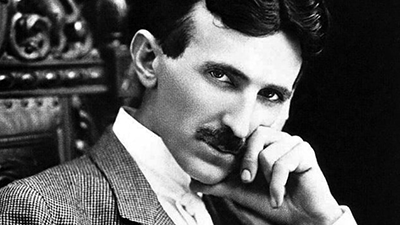Nikola Tesla’s Inventions
Throughout his career, Tesla discovered, designed and developed ideas for a number of important inventions — most of which were officially patented by other inventors — including dynamos (electrical generators similar to batteries) and the induction motor. He was also a pioneer in the discovery of radar technology, X-ray technology, remote control and the rotating magnetic field — the basis of most AC machinery. Tesla is most well-known for his contributions in AC electricity and for the Tesla coil. AC Electrical System Tesla designed the alternating-current (AC) electrical system, which would quickly become the preeminent power system of the 20th century and has remained the worldwide standard ever since. In 1887, Tesla found funding for his new Tesla Electric Company, and by the end of the year he had successfully filed several patents for AC-based inventions.
Tesla's AC system soon caught the attention of American engineer and businessman George WestinghousGeorge Westinghousee, who was seeking a solution to supplying the nation with long-distance power. Convinced that Tesla's inventions would help him achieve this, in 1888 he purchased his patents for $60,000 in cash and stock in the Westinghouse Corporation. As interest in an AC system grew, Tesla and Westinghouse were put in direct competition with Thomas Edison, who was intent on selling his directcurrent (DC) system to the nation. A negative-press campaign was soon waged by Edison, in an attempt to undermine interest in AC power. Unfortunately for Thomas Edison, the Westinghouse Corporation was chosen to supply the lighting at the 1893 World's Columbian Exposition in Chicago, and Tesla conducted demonstrations of his AC system there.
When and Where Was Nikola Tesla Born?
Nikola Tesla was born on July 10, 1856, in what is now Smiljan, Croatia. Childhood and Education
Nikola Tesla was one of five children, including siblings Dane, Angelina, Milka and Marica. Tesla's interest in electrical invention was spurred by his mother, Djuka Mandic, who invented small household appliances in her spare time while her son was growing up. Tesla's father, Milutin Tesla, was a Serbian orthodox priest and a writer, and he pushed for his son to join the priesthood. But Nikola's interests lay squarely in the sciences. After studying at the Realschule, Karlstadt (later renamed the Johann-Rudolph-Glauber Realschule Karlstadt); the Polytechnic Institute in Graz, Austria; and the University of Prague during the 1870s, Tesla moved to Budapest, where for a time he worked at the Central Telephone Exchange. It was while in Budapest that the idea for the induction motor first came to Tesla, but after several years of trying to gain interest in his invention, at age 28 Tesla decided to leave Europe for America. Tesla and Thomas Edison
In 1884 Tesla arrived in the United States with little more than the clothes on his back and a letter of introduction to famed inventor and business mogul Thomas EdisoThomas Edisonn, whose DC-based electrical works were fast becoming the standard in the country. Edison hired Tesla, and the two men were soon working tirelessly alongside each other, making improvements to Edison's inventions. Several months later, the two parted ways due to a conflicting business-scientific relationship, attributed by Several months later, the two parted ways due to a conflicting business-scientific relationship, attributed by historians to their incredibly different personalities: While Edison was a power figure who focused on marketing and financial success, Tesla was commercially out-of-tune and somewhat vulnerable. First Solo Venture
In 1885, Tesla received funding for the Tesla Electric Light Company and was tasked by his investors to develop improved arc lighting. After successfully doing so, however, Tesla was forced out of the venture and for a time had to work as a manual laborer in order to survive. His luck would change two years later, when he received funding for his new Tesla Electric Company.